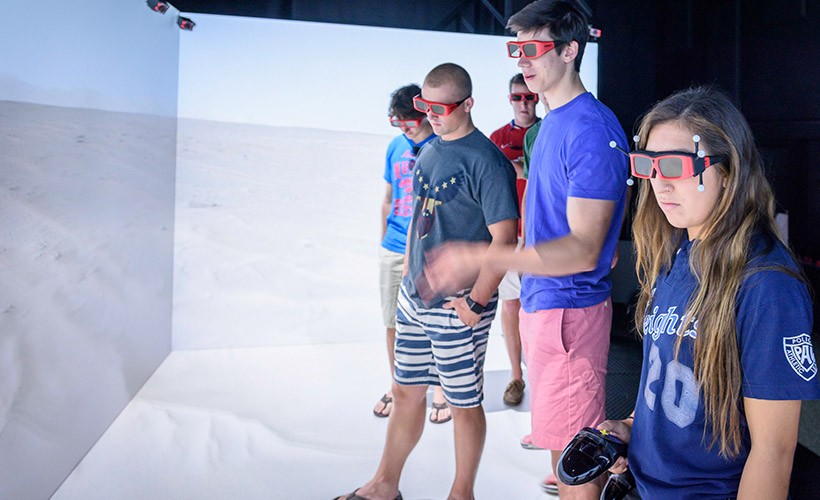CAVE AUTOMATIC VIRTUAL ENVIRONMENT

Villanova’s CAVE Automatic Virtual Environment (CAVE) is an immersive, interactive experience with 3D virtual reality worlds, 3D big-data displays and 3D models of real-world locations and objects, bringing course material to life in new and exciting ways.
Funded by a $1.67 million National Science Foundation grant and managed by CEET, the CAVE opened in October 2014 and is located Falvey Memorial Hall. In addition to serving as a teaching and learning space, it is used to support faculty research projects across disciplines, as well as to collaborate with academic and industry researchers from around the world.
Distinguished by its size and scope, the CAVE is an 18 ft wide by 10 ft deep by 7.5 ft high enclosure allowing 20 viewers to interact at one time with a virtual world. There is an extendable ceiling so the CAVE can project on either three walls and a floor or three walls and a ceiling. Integrated with the CAVE is Seemore the robot—capturing video that covers 360 degrees horizontally and 280 degrees vertically and can be controlled interactively in the CAVE.
Teaching and learning
Faculty across disciplines and colleges use the CAVE to bring class material to life, such as Noël Falco Dolan, EdD, who brought her Augustine and Culture Seminar class into a Harlem Renaissance-era blues club to study Langston Hughes poetry. Computer Science students used the CAVE to create a digital crime scene as part of the “Digital Forensics” course, and Engineering students can step inside atomic crystal structures in metal and semiconductor materials.
Commitment to Research
The CAVE presents an opportunity for faculty and students to bring their research to life. Examples include:
- The annual Villanova University Virtual Reality Competition—open to students, faculty and staff—showcases exciting interactive projects developed in the CAVE.
- Andrej Prsa, PhD, Astronomy and Astrophysics, developed an interactive CAVE display for his NSF-supported PHOEBE project to develop and refine models involving eclipsing binary stars.
- Mark Jupina, PhD, Electrical and Computer Engineering, developed a virtual reality baseball training environment so players can hone their skills in pitch recognition and eye tracking.
Collaborations with the Vatican
The Center has an ongoing collaborative relationship with the Vatican, designing 3D virtual reality tours of the Sistine Chapel, the Pope’s rarely seen Redemptoris Mater Chapel, Radio's Marconi Museum and other major basilicas and sacred places in Rome.
The CAVE is a research tool for faculty and students on campus as well as community partners around the world. Faculty interested in using existing course presentations in the CAVE should contact scheduling coordinator Jessica Peoples prior to the start of the semester. Faculty members and other researchers interested in developing new material should contact center director Frank Klassner.
The CAVE Youth Program invites K – 12 educators to visit the CAVE with their students.
